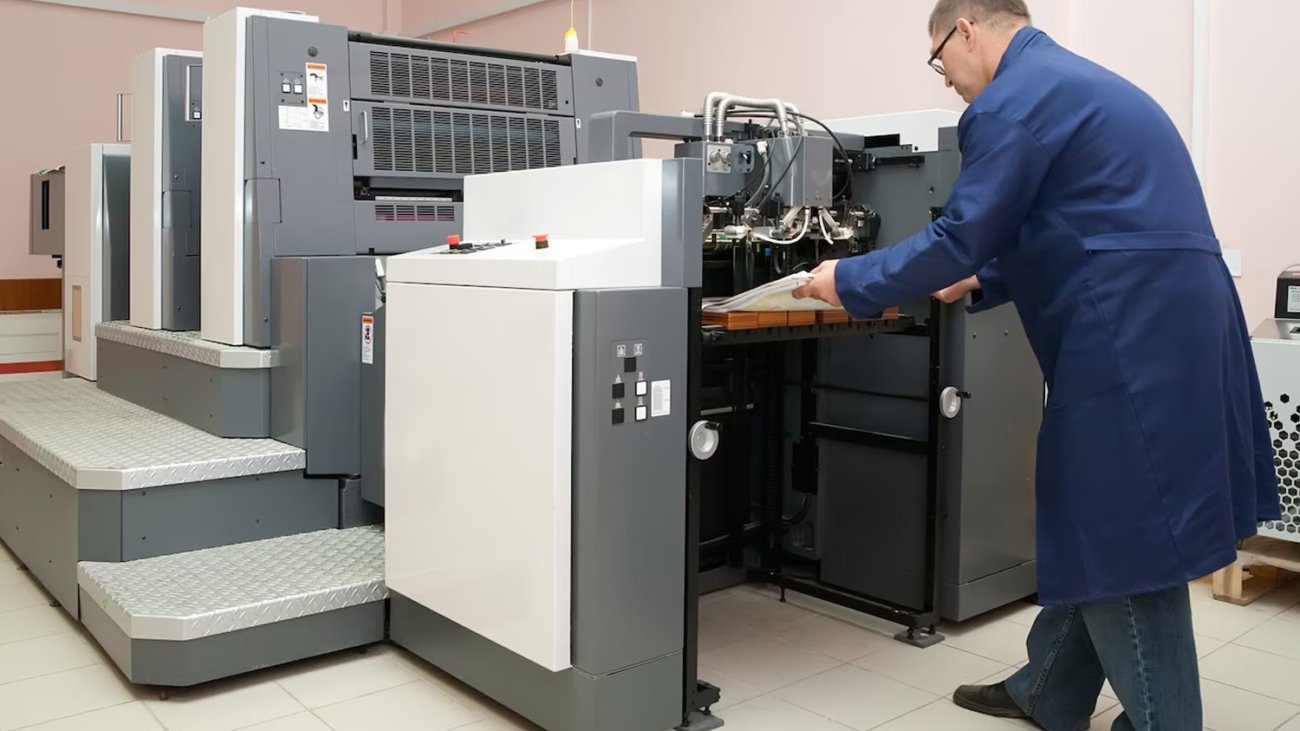From conventional press operations to sophisticated digital technology, the printing company has experienced significant variances in recent years. This change presents financial possibilities for marketers wishing to launch a modest printing commercial business. Given the expected $472.35 billion worldwide commercial printing market in 2024, starting a small printing business can be highly profitable, with printing services particularly in demand, especially in sectors such as virtual printing, environmentally friendly solutions, and custom print products. This manual addresses the main activities of running a hit printing company: market research, criminal difficulties, gadget investment, advertising, and marketing tactics.
Understanding the Printing Market
Before starting a printing company, comprehensive market research is crucial to identify industry trends, competition, and consumer demand. Industrial printing, print-on-demand (POD), ecological printing, and 3-D printing are just a few areas that make up the varied print business. For example, the POD sector has acquired popularity recently and is expected to reach $39.87 billion by 2030. Entrepreneurs must find their target market and choose which niche fits their knowledge level and financial capacity.
Sustainability is another key aspect shaping the enterprise. Eco-friendly printing solutions, including biodegradable inks, recycled paper, and power-efficient printing techniques, could increase demand as consumers and businesses get more ecologically sensitive. Businesses prioritizing sustainability will stand out from rivals and attract a growing segment of socially conscious consumers.
Remember also technological developments inside the sector. Thanks in significant part to its cost-effectiveness and efficiency, digital printing has become the leading player in the market and is often replacing traditional offset printing. Additionally, the upward push of automation, artificial intelligence (AI), and cloud-based wholly printing solutions are changing the organization, letting companies simplify manufacturing and enhance consumer experiences. Those who live ahead of rivals and reflect these technical developments can improve productivity.
Creating a Business Plan

Any hit printing commercial venture starts from a well-established company plan. It has to specify the offers made, target market, pricing strategy, and marketing plan. Entrepreneurs could choose whether to concentrate on digital printing, screen printing, big-layout printing, and areas of expertise services, including 3-D printing. Every service requires different tools, chemicals, and knowledge; thus, choosing the appropriate niche is essential for long-term success.
Another vital component of a business plan is financial strategies. Depending on the type of printing offered, startup expenses for a small printing company range from $10,000 to $50,000. Expenses cover gadget purchasing, workplace leasing, raw material buying, and marketing campaigns. Ensuring financial balance during the first degrees of operation depends on knowing which resources—small business loans, grants, or non-public investments—enable funding capabilities. Entrepreneurs also have to consider developing a backup strategy to handle possible obstacles, including changes in supply chains, varying material pricing, or financial crises.
Legal Issues with Corporate Registration
The first essential actions before starting a business are registering the commercial entity and adhering to local legislation. Entrepreneurs should select a legal form: sole proprietorship, limited liability company (LLC), or corporate entity, depending on their responsibility choices and business goals. Working lawfully and protecting the company from hazards depends on obtaining crucial business licenses, tax identification numbers, and coverage insurance.
Widespread legal responsibility insurance and system insurance are two examples of insurance coverage that helps the company avoid financial losses resulting from legal conflicts, system breakdowns, or injuries. Furthermore, setting up a correct bookkeeping tool and information tax obligations ensures reasonable economic control and tax law compliance. Entrepreneurs must discuss financial and criminal lawyers to ensure they follow all legal rules and avoid any criminal problems in the future.
Investing in Printing Equipment and Technology
The need for printing gadgets depends on the presented offers. While screen printing systems are necessary for creating custom clothing and promotional goods, digital printers are ideal for organizations that specialize in on-demand printing. Large-format printers are utilized extensively in banners, posters, and signage; 3-D printers help businesses concentrate on custom prototypes and production.
Online buying, product customization, and automatic printing methods let the integration of the internet—to—print solutions improve client experience. Advanced printing software packages and workflow automation solutions help simplify order processing, reduce operating costs, and increase efficiency. Purchasing first-rate gadgets guarantees speedier turnaround times and improved print quality, raising customer satisfaction and regular business.
Setting Up the Business Location
Entrepreneurs should choose to operate from a retail storefront, a domestic-based completely set-up, or an internet platform. Startups with limited money find a domestic-primarily based company appealing since it offers reduced overhead rates and flexibility. However, a retail location offers more visibility and walk-in traffic, which can help draw local businesses. Once more, online technologies let companies reach a larger target audience and provide easy ordering choices through e-commerce websites.
Whatever the location, the workplace should have enough airflow, a garage for chemicals, and enough space for manufacturing tools. A neat and effective workspace helps to ensure smooth business operations and productivity. Security precautions should also be taken, mainly if on-website savings of expensive systems and materials help to offset their costs.
Hiring and Staffing Needs
Hiring qualified experts can be crucial based on the size of the business. A small printing company might also need graphic designers to assist customers with design needs, gadget operators to handle printing devices, and sales staff to manage consumer questions and order processing. Outsourcing design solutions or using freelancers might be a cost-effective fix for companies with tighter budgets.
Employee training is crucial for ensuring that staff members are proficient in running printing machines, using design software programs, and handling customer care contacts. Offering continuous education helps keep the team current on industry trends and new printing technologies and meets perfect standards. Companies should also not overlook funding staff enhancement initiatives to raise general productivity and skill sets.
Marketing and Customer Acquisition
Attracting and keeping customers depends on a strong emblem presence. Creating a professional website highlighting printing alternatives, pricing, and layout choices can help credibility and simplify client region ordering. For print product sales, social media channels such as LinkedIn, Facebook, and Instagram are priceless tools; they attract potential consumers and allow you to share client endorsements.
Local advertising can help promote logo awareness through leaflets, business networking events, and partnerships between several small companies. Discounts, promotions, and referral incentives enable clients to test the products and assist the business in being suggested to others. Establishing a loyal customer base mostly depends on providing first-rate customer care and guaranteeing timely delivery of premium print products. To reach more broadly, entrepreneurs should also investigate digital advertising strategies, including pay-consistent with-click advertising and marketing, search engine optimization (search engine marketing), and e-mail advertising campaigns.
Managing Finances and Ensuring Profitability
Maintaining a profitable printing commercial company depends on sound financial control. Entrepreneurs must routinely examine business margins, pay song charges, and handle screen income. Accounting software programs can streamline bookkeeping tasks and offer an understanding of financial performance.
Competitive pricing is crucial for attracting customers and maintaining profitability. Investigating industry pricing criteria and changing prices based on manufacturing costs, material expenses, and market demand helps reconcile commercial enterprise sustainability with affordability. Entrepreneurs should also find ways to maximize operational effectiveness and lower waste to increase income margins.
Keeping Up with Industry Trends
The printing company is always changing, and keeping current with developing features will help one stay competitive. Artificial intelligence (AI) is becoming increasingly popular in helping to improve print quality, automate daily tasks, and beautify design processes. Print technologies driven by AI streamline manufacturing, cut waste, and enhance growth performance.
Sustainability tasks help to keep momentum as more printing enterprises apply eco-friendly methods to lower their impact. Using recycled paper, water-based complete inks, and power-efficient devices fits customer possibilities and enhances the organization’s reputation.
Conclusion
Starting a small printing business requires careful planning, high-quality device funding, and a thorough awareness of consumer trends. By concentrating on innovation, consumer delight, and sustainability, printing enterprises can establish a strong position in the market and achieve long-term profitability.

